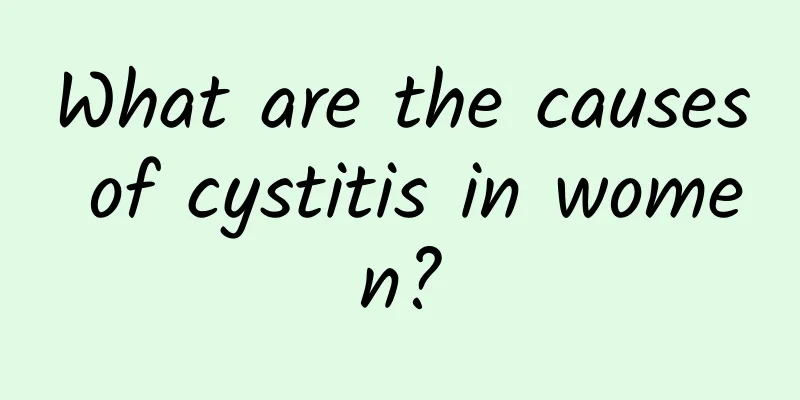What are the causes of cystitis in women?

|
Cystitis is a relatively common urinary system disease, especially women are particularly prone to cystitis. They often experience symptoms such as urgency and frequent urination, which seriously troubles our normal life and also affects our physical health. Since we know very little about cystitis, we don’t always know how to prevent it effectively. Let’s take a look at the causes of cystitis in women. Cystitis is a disease that is more common in women and is one of the most common diseases in the urinary system. Clinically, it can be divided into acute cystitis and chronic cystitis. Nonspecific cystitis is more likely to occur if there are lesions in the female bladder itself, such as bladder stones, foreign bodies, and indwelling catheters, or if there is urinary tract obstruction and urination difficulties. 1. Causes of cystitis in women Cystitis is a lower urinary tract infection, which is more common in women. The pathogen is mostly E. coli. When a woman's urinary system is infected, the bacteria invade through two routes: ascending infection and bloodstream infection. Therefore, cystitis is mostly caused by infection. 1. Urinary tract obstruction: Such as urethral stones, stenosis, tumors, prostate hypertrophy, etc., which make urine excretion difficult, cause bacterial growth and cause infection. 2. Urinary system malformations and abnormal functions: For example, renal hypoplasia, horseshoe kidney, polycystic kidney, ureteral malformation, etc. can cause partial urinary tract obstruction or vesicoureteral reflux, causing infection; abnormal urination function of neurogenic bladder can lead to urinary retention and bacterial infection. 3. Urinary system instrument examination: Catheterization, cystoscopy and urinary tract surgery cause nosocomial infection. 4. Weakened body resistance: Conditions such as diabetes, use of immunosuppressants (such as corticosteroids), leukopenia, and malnutrition can easily lead to urinary tract infections. 5. Improper sexual life: Unclean sexual life and systemic viral infection are often important triggering factors of female cystitis. 2. What are the symptoms of female cystitis? 1. Acute cystitis: It can occur suddenly or slowly. There is burning pain in the urethra during urination, frequent urination, often accompanied by urinary urgency. In severe cases, it is similar to urinary incontinence. The urinary frequency and urgency are often particularly obvious, up to 5 to 6 times per hour. The amount of urine each time is not much, even only a few drops. There may be lower abdominal pain at the end of urination. The urine is turbid, and sometimes there is hematuria, which is often obvious in the late stage. If there is macroscopic hematuria, it is called acute hemorrhagic cystitis. There is mild tenderness in the suprapubic bladder area. Some patients may experience mild back pain. When the inflammatory lesions are limited to the bladder mucosa, there is often no fever or leukocytosis in the blood, and the systemic symptoms are mild. Some patients feel tired. Acute cystitis in women after marriage is called honeymoon cystitis. Acute cystitis has a short course. If treated in time, the symptoms usually disappear in about 1 week. 2. Chronic cystitis: Frequent urination, urgency, and pain during urination are long-term and recurrent, but not as severe as the acute phase. There are small or moderate amounts of pus and red blood cells in the urine. If cystitis is treated promptly, the symptoms will disappear quickly. At this time, patients should not take it lightly and should insist on acute treatment for one week. Stop after the doctor confirms that the cystitis has been cured through examination. Do not let cystitis turn into a chronic disease. In fact, as long as we can pay more attention to and improve bad living habits in life, we can effectively prevent and avoid the occurrence of some diseases. After understanding the causes of female cystitis, we can effectively prevent cystitis. We must pay attention to physical hygiene in daily life and do not have multiple sexual partners. |
<<: 3 ways to hit a man's weak spot in love
>>: How to care for oily skin for men
Recommend
Right testicular swelling
The testicles are located on the inner side of th...
Symptoms of high hormone secretion
Many male friends hope that they can have suffici...
Male genital urethral itching
Now many men have problems with their urethra. So...
What is the reason for the sperm being too thin?
There are many different colors of male sperm, so...
Does vasectomy affect men's sexual function?
Male sterilization is a simple and safe contracep...
What is an irritating dry cough? What is the nature of the cough?
Coughing is a protective respiratory reflex actio...
Simple exercise method to treat premature ejaculation
Premature ejaculation is a symptom that is very c...
Foods that patients with prostatitis should avoid
During the treatment of prostatitis, patients sho...
How to treat male warts?
Male genital warts are one of the more common sex...
Thickening of the scrotal skin
The scrotum is where men produce sperm. Although ...
What is the disease of glans erosion?
The glans penis is a very important male sexual o...
To nourish the kidneys, prevent stroke, and relieve stress, men only need to do one move
Kinetic energy generates Yang, and there are many...
Why do boys habitually support their chin with their left hand?
Everyone has their own habits. Many boys habitual...
Signs of Penis Cancer
Penile cancer is a cancer of the male reproductiv...
Symptoms and treatment methods of excessive sexual indulgence in men
It is understandable that young people are easily...









